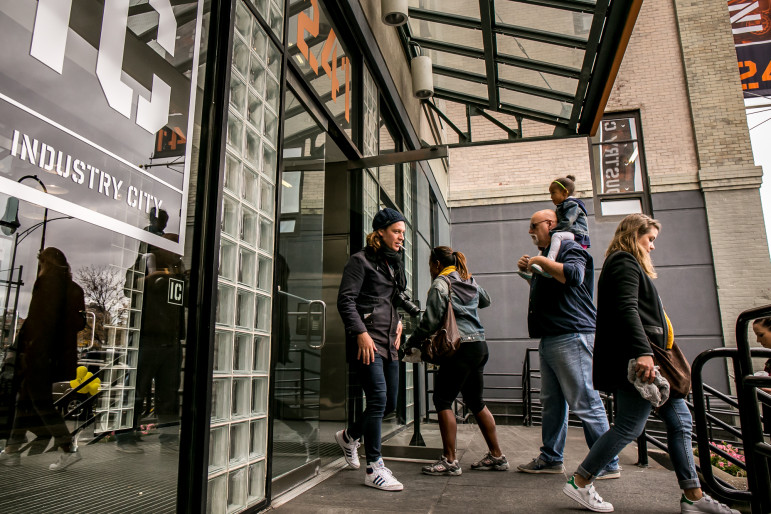‘The narrative that New York is anti-business, triggered by the recent defeat of the Industry City proposal, is not only misleading, but simplistic.’

Adi Talwar
Brooklyn’s Industry City, during pre-pandemic times.The narrative that New York is anti-business, triggered by the recent defeat of the Industry City proposal, is not only misleading, but simplistic. It undermines efforts to build an effective process for identifying and addressing problems with large scale development proposals early on so that they can move forward with clear benefits to their surrounding communities and the city overall.
For decades, the predominant economic development strategy could be summed up in the catechism “Build it, and businesses will come.” But this strategy has been increasingly questioned as think tanks and city halls around the country recognized that the talent of the workforce was also hugely influential in location decisions.
Moving forward, the city needs to place education, workforce development and ensuring the vitality of all its neighborhoods at the core of its economic development strategy.
 CityViews are readers’ opinions, not those of City Limits. Add your voice today!
CityViews are readers’ opinions, not those of City Limits. Add your voice today!
The anti-business narrative got a big boost when Amazon decided not to build a second headquarters here last year. But Amazon did not abandon New York, it abandoned the terms that electeds and community members were demanding in exchange for substantial public subsidies. Since its withdrawal from those negotiations, it leased 335,000 square feet in Hudson Yards and bought the 660,000-square-foot Lord & Taylor building on Fifth Avenue. Amazon wants to be here not for the city’s real estate, but for its people and their talent and expertise. So do Google and Facebook, to name just two companies in the big tech world who are expanding dramatically in New York.
The Industry City development was conceived for the pre-Covid market and, to an outside observer, it just became increasingly risky, changing both the public’s and maybe the developer’s estimation of the wisdom of the proposal. Its assumptions were dependent on workers getting on a subway at a time when the office market is readjusting, both in the short and long terms, to accommodate those opting to work remotely.
Building more hotel and retail space, other components of the proposal, has also become increasingly risky as hotels and stores across the city are going bankrupt. Finally, the value of some of its land for last-mile warehouse space surged during the pandemic and Industry City can develop that without a zoning change. In short, Industry City was designed for the pre-Covid world, and the world changed. The new reality changed the value proposition.
These two projects cannot be interpreted to mean the city is anti-business and communities have too much power. In fact, UPROSE and others in the community surrounding Industry City proposed a different business strategy focused on the growth of businesses engaged in addressing climate change, a sector that will inevitably grow. The fact that the owners and community had different business strategies does not make either one of them anti-business.
The experiences of Amazon and Industry City do reveal two important problems with the city’s overall economic development strategy: its overreliance on land use as a mechanism for growth, to the exclusion of holistic planning, and insufficient support from the city to realize job projections.
First, if Amazon and Industry City were important economic development initiatives, why were the communities’ only opportunities to negotiate with the developers and the city during the rezoning of the land? The scope of what a zoning change can address is inherently inadequate for addressing other issues. Without more comprehensive planning that addresses the citywide and neighborhood pictures, every need—whether for more schools, parks, affordable housing, fire stations or libraries—gets played out during a zoning change. The city needs alternative processes for assessing, raising and addressing the spectrum of resources every community needs to be vibrant.
Second, the promise of jobs for residents is hollow unless there is the infrastructure surrounding the project to support the education and training of residents for those future jobs. Communities of color have lived these broken promises again and again. In Amazon’s case, there was a minimal commitment—some job fairs and some matchmaking—in the original proposal. And while this commitment got stronger during the process, it couldn’t overcome the initial skepticism created by the weak proposal, the absence of an existing infrastructure to help fulfill that commitment and hold the developers accountable.
In Industry City’s case, the leadership came from the Brooklyn Navy Yard, a mission-driven public-private partnership. They had a strong track record of supporting the employment of local residents and had already begun putting programs in place. But at Industry City, City Hall was absent. Only the city can provide a school or the other workforce resources needed to make job commitments a reality, and the mayor declined to participate, which made the opportunity for much greater employment far less credible.
Some other cities require developers seeking such zoning changes to provide a tenant engagement plan. An engagement plan does not lock in a specific tenant, but describes the process through which the developer will connect tenants with employment and community groups. If the justification for a zoning change is job creation, it is not too much to make sure that actually happens through city-supported policy.
Finally, while the real estate development community may be concerned about workers leaving the city, working remote and not tenanting their buildings, there is an alternative. This is a city of 9 million people. The city should focus less on attracting the “best and brightest” and more on ensuring that the more than one million students in our public schools have the support they need to be the best and brightest for generations to come.
Adam Friedman is Director of the Pratt Center for Community Development. This statement reflects the position of Pratt Center for Community Development and not Pratt Institute.








